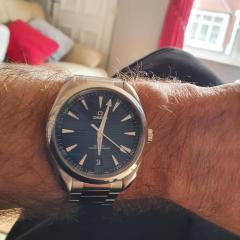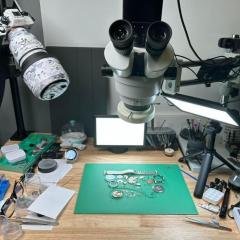-
Recently Browsing
- No registered users viewing this page.
-
Topics
-
Posts
-
what you made will probably last longer too, I could not find a supplier either, you would think something so simple would be available......
-
By spectre6000 · Posted
Two pushers and a crown on the right. As expected. What's the left crown do? Rotating inner bezel? -
By spectre6000 · Posted
Just had an epiphany: I have a meaningful percentage of a gallon jug of L&R Extra Fine Watch US solution. Costs the same as a new gallon of clock cleaning solution, only I already have it. Should work just fine, right? I'll need to do a thorough pre-clean to get rid of the axle grease though... What would work to preclean without damaging existing lacquer? I imagine the L&R will probably be gentle on any existing lacquer as long as I don't strip it all off with whatever I pre-clean with. Also, I have pounds of various grades of shellac flakes (actually, maybe only two grades right now...). Historically, I'm sure that's what would have been used on metals like this. Any reason that wouldn't work? I could make up a small thin batch, and it would brush on easily. Should be easy enough to keep it out of pivot holes, and an alcohol soaked string would be all it would take to clean up any mistakes. Any reason that wouldn't work in the event re-lacquering is required/desired? -
By nevenbekriev · Posted
When I need to make screw, I use soft У10А, which is russian steel, very similar to O1. I would use O1, but for me it is harder to source because of the place I live. When I need blue steel, I usually temper to blue rollers from roller bearings. When turning blue steel with HSS gravers, You will not only have to resharpen the graver, but to sharpen it often (several times while turning). This is not only sharpening, but polishing too. I find for myself carbide gravers are much better, but this is personal and one will find for himself what serves better for His needs. High speed (revolutions) is not needed as the friction will cause heat and heat can make the work to harden and the HSS graver to get dull. If You notice the graver is not cutting well, then sharpen it immediately. Blue steel is easy to work harden with dull graver and it is hard to get rid of the hardened portion, especially with HSS graver. Work hardening has nothing to do with heat/quench hardening, it is rather due plastic deforming on the surface by dull graver or drill bit. -
Not sure if I said it clear enough: - remove 1 - mount the anvil plate on 2 Frank
-




Recommended Posts
Join the conversation
You can post now and register later. If you have an account, sign in now to post with your account.
Note: Your post will require moderator approval before it will be visible.